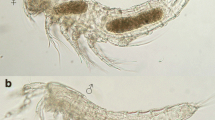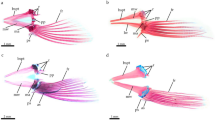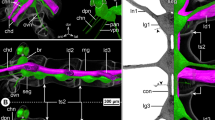Abstract
Pycnogonids are a small group of archaic primarily marine chelicerates. They exhibit an unusual bauplan and some features that distinguish them from the rest of the chelicerates. There are approximately ten modern families of pycnogonids and more than 1000 species. However, the knowledge of this group consists of information about the organization of several dozen species, which does not comprise the available diversity. Species of the family Colossendeidae are poorly studied. Using light microscopy, we examined the morphology of Colossendeis drakei Calman, 1915, C. fragilis Pushkin, 1993, C. scotti Calman, 1915, and Decolopoda australis Eights, 1835 and obtained some information about their anatomy. The external structure of each species is described, data on the presence and position of the main organ systems are given. The study of the bauplan of colossendeids revealed the consolidation of the body and the absence of functional segmental boundaries. Our results significantly expand the understanding of the body plan in pycnogonids. Thus, there is a tendency for the midgut surface area to increase through elongation of the midgut diverticula and/or the formation of infoldings. In females, the vitellarium is hypertrophied and extends almost the entire length of the walking leg. The presence of the gonad diverticula in male pycnogonids is described for the first time.






Similar content being viewed by others
REFERENCES
Pushkin, A.F., Fauna mnogokolenchatykh (Pycnogonida) Yuzhnogo okeana, Issled. fauny morey, XX (XXX), Rezul’taty biologicheskikh issledovanii sovetskikh antarkticheskikh ekspeditsii (The Pycnogonid Fauna of the Southern Ocean, Exploration of the Fauna of the Seas XX (XXX), Results of Biological Investigations by Soviet Antarctic Expeditions), 1993, vol. 8.
Alexeeva, N. and Tamberg, Y., Anatomical changes in postembryonic development of Pycnogonum litorale, J. Morphol., 2021, vol. 282, no. 3, pp. 329–354.
Alexeeva, N., Tamberg, Y., and Shunatova, N., Postembryonic development of pycnogonids: a deeper look inside, Arthropod Struct. Dev., 2018, vol. 47, no. 3, pp. 299–317.
Arabi, J., Cruaud, C., Couloux, A., and Hassanin, A., Studying sources of incongruence in arthropod molecular phylogenies: sea spiders (Pycnogonida) as a case study, C. R. Biol., 2010, vol. 333, no. 5, pp. 438–453.
Arango, C.P. and Wheeler, W.C, Phylogeny of the sea spiders (Arthropoda, Pycnogonida) based on direct optimization of six loci and morphology, Cladistics, 2007, vol. 23, no. 3, pp. 255–293.
Arnaud, F. and Bamber, R.N., The biology of Pycnogonida, Adv. Mar. Biol., 1987, vol. 24, pp. 1–96.
Bamber, R.N., A second Pallenopsis mollissima (Hoek), with other deep water pycnogonids from the Glasgow Museum, Zool. J. Linn. Soc., 1985, vol. 83, no. 4, pp. 301–306.
Bergström, J., Stürmer, W., and Winter, G., Palaeoisopus, Palaeopantopus and Palaeothea, pycnogonid arthropods from the lower Devonian Hunsrück slate, West Germany, Paläontol. Z., 1980, vol. 54, no. 1, pp. 7–54.
Calman, W.T. and Gordon, I., A dodecapodous pycnogonid, Proc. R. Soc. London, Ser. B, 1933, vol. 113, no. 781, pp. 107–115.
Cano-Sánchez, E. and López-González, P.J., Basal articulation of the palps and ovigers in Antarctic Colossendeis (Pycnogonida; Colossendeidae), Helgol. Mar. Res., 2017, vol. 70, no. 1, pp. 1–8.
Dunlop, J.A. and Arango, C.P., Pycnogonid affinities: A review, J. Zool. Syst. Evol. Res., 2005, vol. 43, no. 1, pp. 8–21.
Fahrenbach, W.H., Microscopic anatomy of Pycnogonida: 1. Cuticle, epidermis, and muscle, J. Morphol., 1994, vol. 222, no. 1, pp. 33–48.
Fahrenbach, W.H. and Arango, C.P., Microscopic anatomy of Pycnogonida: 2. Digestive system. 3. Excretory system, J. Morphol., 2007, vol. 268, no. 11, pp. 917–935.
Firstman, B., The relationship of the chelicerate arterial system to the evolution of the endosternite, J. Arachnol., 1973, pp. 1–54.
Fry, W.G., The feeding mechanisms and preferred foods of three species of Pycnogonida, Bull. Br. Mus. (Nat. Hist.), Zool., 1965, vol. 12, pp. 195–223.
Hedgpeth, J.W., The Pycnogonida of the western North Atlantic and the Caribbean, Proc. U. S. Natl. Mus., 1947, vol. 97, pp. 157–342.
Helfer, H. and Schlottke, E., Pantopoda, Bronns Klassen und Ordnungen des Tier-Reichs, 1935, Bd. 5, Abt. IV, Buch 2.
King, P.E., Pycnogonids, London: Hutchinson, 1973.
Kühl, G., Poschmann, M., and Rust, J., A ten-legged sea spider (Arthropoda: Pycnogonida) from the lower Devonian Hunsrü ck slate (Germany), Geol. Mag., 2013, vol. 150, no. 3, pp. 556–564.
Masta, S.E., McCall, A., and Longhorn, S.J., Rare genomic changes and mitochondrial sequences provide independent support for congruent relationships among the sea spiders (Arthropoda, Pycnogonida), Mol. Phylogenet. Evol., 2010, vol. 57, no. 1, pp. 59–70.
Miyazaki, K. and Makioka, T., Structure of the adult female reproductive system in the sea spider, Propallene longiceps (Pycnogonida, Callipallenidae) and its functional and evolutionary significance, Invertebr. Reprod. Dev., 2010, vol. 54, no. 1, pp. 35–39.
Okuda, S., Metamorphosis of a Pycnogonid parasitic in a Hydromedusa (with 10 text-figures), J. Fac. Sci. Hokkaido Imp. Univ., Ser. VI. Zoology, 1940, vol. 7, no. 2, pp. 73–86. http://hdl.handle.net/2115/27023.
Poschmann, M. and Dunlop, J.A., A new sea spider (Arthropoda: Pycnogonida) with a flagelliform telson from the Lower Devonian Hunsrück Slate, Germany, Palaeontology, 2006, vol. 49, no. 5, pp. 983–989.
Rudkin, D.M., Cuggy, M.B., Young, G.A., and Thompson, D.P., An Ordovician pycnogonid (sea spider) with serially subdivided ‘head’ region, J. Paleontol., 2013, vol. 87, no. 3, pp. 395–405.
Soler-Membrives, A., Rossi, S., and Munilla, T., Feeding ecology of Ammothella longipes (Arthropoda: Pycnogonida) in the Mediterranean Sea: a fatty acid biomarker approach, Estuarine, Coastal Shelf Sci., 2011, vol. 92, no. 4, pp. 588–597.
Soler-Membrives, A., Arango, C.P., Cuadrado, M., and Munilla, T., Feeding biology of carnivore and detritivore Mediterranean pycnogonids, J. Mar. Biol. Assoc. U. K., 2013, vol. 93, no. 3, pp. 635–643.
Schmidt-Nielsen, K., Scaling: Why is Animal Size So Important?, Cambridge: Cambridge Univ. Press, 1984.
Siveter, D.J., Sutton, M.D., Briggs, D.E., and Siveter, D.J., A Silurian sea spider, Nature, 2004, vol. 431, no. 7011, pp. 978–980.
Vilpoux, K. and Waloszek, D., Larval development and morphogenesis of the sea spider Pycnogonum litorale (Ström, 1762) and the tagmosis of the body of Pantopoda, Arthropod Struct. Dev., 2003, vol. 32, no. 4, pp. 349–383.
Wagner, P., Dömel, J.S., Hofmann, M., et al., Comparative study of bisected proboscides of Pycnogonida, Org. Diversity Evol., 2017, vol. 17, no. 1, pp. 121–135.
Wheeler, W.C. and Hayashi, C.Y., The phylogeny of the extant chelicerate orders, Cladistics, 1998, vol. 14, no. 2, pp. 173–192.
Wicksten, M.K., Feeding on cnidarians by giant pycnogonids (Pycnogonida: Colossendeidae Jarzinsky, 1870) in the north Central Pacific and North Atlantic oceans, J. Crustacean Biol., 2017, vol. 37, no. 3, pp. 359–360.
ACKNOWLEDGMENTS
The author is grateful to S.G. Denisenko, the head of the Marine Research Laboratory, for the opportunity to work with the collections of the Zoological Institute of the Russian Academy of Sciences and to E.L. Markhaseva for consultations while working with the material of collections.
Funding
This study was performed using the equipment of the Department of Invertebrate Zoology of St. Petersburg State University, as well as equipment of the Research Resource Center “Taxon” (http://www.ckp-rf.ru/ckp/3038/), and is part of the State Assignment Project (no. AAAA-A19-119022690122-5) of the Zoological Institute of the Russian Academy of Sciences.
Author information
Authors and Affiliations
Corresponding author
Ethics declarations
Conflict of interests. The author declares no conflict of interest.
Statement on the welfare of animals. All applicable international, national, and/or institutional guidelines for the care and use of animals were followed.
Rights and permissions
About this article
Cite this article
Alexeeva, N.V. The Morphology and Some Data on the Anatomy of Pycnogonids of the Family Colossendeidae (Arthropoda: Chelicerata). Russ J Mar Biol 47, 440–450 (2021). https://doi.org/10.1134/S106307402106002X
Received:
Revised:
Accepted:
Published:
Issue Date:
DOI: https://doi.org/10.1134/S106307402106002X




